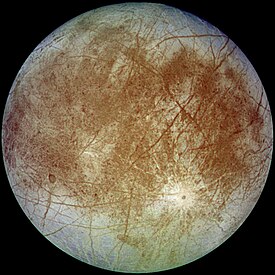Of the four Galilean moons of Jupiter, only the outer three have any potential for human habitation. Inner Io is almost literally hellish.
That leaves Europa, Ganymede and Callisto. Each of these have advantages and drawbacks. Let's look at each.
Europa
First off, let me state that from the standpoint of exploration and exobiolgy, Europa is the gold mine of our solar system. Europa is is by far the best candidate for extraterrestrial life of any of the Sun's worlds other than our earth. In fact, Europa has potential to host not only individual prokaryotic life, but colonial prokaryotes and possibly eukaryotes as well. Europa may actually be inhabited by megafauna analogous to that which existed on earth during the Ediacaran and Cambrian periods of earth's history. In simple terms, Europa's oceans may harbor life that would be readily recognizable as such by a casual observer without a microscope.
Which means that Europa is very likely off-limits for human colonization. Also, of the three moons Europa is the closest to Jupiter's radiation, receiving about 540 rem per day on the surface, which is a fatal dose for humans. The 100 kilometer thick ice mantle would provide adequate radiation shielding, but it takes a long, long time to bore through 100 kilometers of ice.
Ganymede
Ganymede receives only 8 rem per day jovian radiation, which is not fatal in the short term but which would result in chromosomal damage in the long term. Ganymede's oceans lie some 200 kilometers beneath her surface, even less accessible than Europa's. At 5262 kilometers diameter Ganymede is larger than either our moon or Mercury, but because it is mostly made of water ice it's mass and gravity is significantly less than either of these, so this isn't really a very big advantage. Ganymede's oxygen atmosphere is also too thin to be of any real asset.
Callisto
Callisto is nearly as large as Ganymede, and has less liquid water beneath her rock and ice surface. However, she likely has ample water to sustain a significant human population, and is far enough away from Jupiter that she receives only a very acceptable 0.01 rem per day on her surface. In many ways Callisto is the least enticing of the outer Galilean satellites, but she may well be our single best option for colonization within the Jovian planetary system. From her surface Europa would also be much easier to study and explore. One thing about Callisto to consider, though, is that her orbit on the perimeter of Jupiter's gravity means she gets pelted by an awful lot of interplanetary debris, especially on the hemisphere facing away from Jupiter. Any colony on Callisto would definitely need to watch for falling rocks. On the other hand, any colony on Callisto would certainly be on the hemisphere facing Jupiter. All things considered, Callisto must be numbered on the short list of candidates for human outmigration.



No comments:
Post a Comment